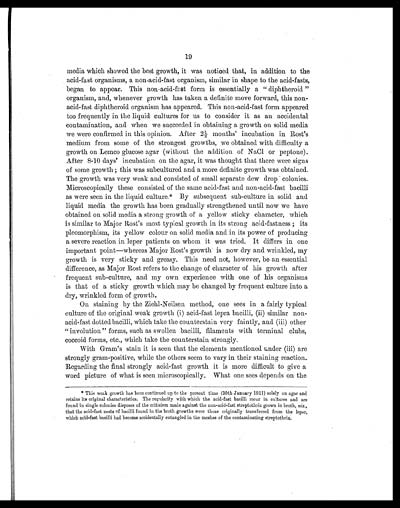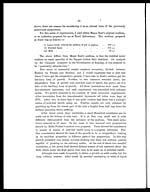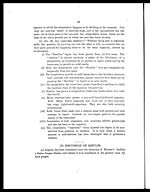Medicine - Institutions > Army health reports and medical documents > Scientific memoirs by officers of the Medical and Sanitary Departments of the Government of India > Number 42 - Cultivation of the bacillus of leprosy and the treatment of cases by means of a vaccine prepared from the cultivations > Part II - Cultivation of the leprosy bacillus
(27) Page 19
Download files
Individual page:
Thumbnail gallery: Grid view | List view

19
media which showed the best growth, it was noticed that, in addition to the
acid-fast organisms, a non-acid-fast organism, similar in shape to the acid-fasts,
began to appear. This non-acid-fast form is essentially a " diphtheroid "
organism, and, whenever growth has taken a definite move forward, this non-
acid-fast diphtheroid organism has appeared. This non-acid-fast form appeared
too frequently in the liquid cultures for us to consider it as an accidental
contamination, and when we succeeded in obtaining a growth on solid media
we were confirmed in this opinion. After 2½ months' incubation in Rost's
medium from some of the strongest growths, we obtained with difficulty a
growth on Lemco glucose agar (without the addition of NaCl or peptone).
After 8-10 days' incubation on the agar, it was thought that there were signs
of some growth; this was subcultured and a more definite growth was obtained.
The growth was very weak and consisted of small separate dew drop colonies.
Microscopically these consisted of the same acid-fast and non-acid-fast bacilli
as were seen in the liquid culture.* By subsequent sub-culture in solid and
liquid media the growth has been gradually strengthened until now we have
obtained on solid media a strong growth of a yellow sticky character, which
is similar to Major Rost's most typical growth in its strong acid-fastness; its
pleomorphism, its yellow colour on solid media and in its power of producing
a severe reaction in leper patients on whom it was tried. It differs in one
important point—whereas Major Rost's growth is now dry and wrinkled, my
growth is very sticky and greasy. This need not, however, be an essential
difference, as Major Rost refers to the change of character of his growth after
frequent sub-culture, and my own experience with one of his organisms
is that of a sticky growth which may be changed by frequent culture into a
dry, wrinkled form of growth.
On staining by the Ziehl-Neilsen method, one sees in a fairly typical
culture of the original weak growth (i) acid-fast lepra bacilli, (ii) similar non-
acid-fast dotted bacilli, which take the counterstain very faintly, and (iii) other
" involution" forms, such as swollen bacilli, filaments with terminal clubs,
coccoid forms, etc., which take the counterstain strongly.
With Gram's stain it is seen that the elements mentioned under (iii) are
strongly gram-positive, while the others seem to vary in their staining reaction.
Regarding the final strongly acid-fast growth it is more difficult to give a
word picture of what is seen microscopically. What one sees depends on the
* This weak growth has been continued up to the present time (30th January 1911) solely on agar and
retains its original characteristics. The regularity with which the acid-fast bacilli recur in cultures and are
found in single colonies disposes of the criticism made against the non-acid-fast streptothrix grown in broth, viz.,
that the acid-fast nests of bacilli found in the broth growths were those originally transferred from the leper,
which acid-fast bacilli had become accidentally entangled in the meshes of the contaminating streptothrix.
Set display mode to: Large image | Zoom image | Transcription
Images and transcriptions on this page, including medium image downloads, may be used under the Creative Commons Attribution 4.0 International Licence unless otherwise stated. ![]()
| Permanent URL | https://digital.nls.uk/75034469 |
|---|
| Shelfmark | IP/QB.10 |
|---|---|
| Additional NLS resources: | |




